| Organic Seeds | Edible Plants | Organic Pest Controls | Books | Tools, Propagation & Fertilisers | Sprouting & Microgreens | Poultry Supplies | Specials & Gift Ideas |

Top

We will send an email to this address*
when is next available
* we will use this email address only for this notification and then we will delete it.
 Home
Home
Green Harvest Organic Gardening Supplies is permanently closed as of 5pm on 1-11-2023.
We will not be taking orders by this website, in person, by phone or email. Our display garden and retail shop are closed forever.
Read more...
Phone:07 54357000
Phone calls will only be responded to sporadically and only in reference to orders placed prior to 2-11-2023. All the useful growing and organic pest management research and resources are available on this website for a while still.
|
|
|
Preparing your planting area ahead of time is very worthwhile - for detailed growing
notes, click the link next to each plant.
List of all plant growing information |
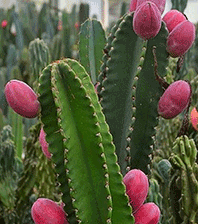 Apple Cactus
UT
Apple Cactus
UTCereus repandus syn. Cereus peruvianus, Lophocereus schottii Not to Norfolk Island, NT, SA, TAS or WA Syn. Peruvian apple cactus, hedge cactus, cadushi. A majestic, thorny, columnar cactus that eventually becomes tree-like, from 2 to 5 m in height. The fruit is similar to Dragonfruit in both appearance and flavour but smaller in size, it ranges in skin colour from orange to red. The white flesh is sweet and juicy with a crunchy texture. The beautiful large, white flowers open at night and are pollinated by night-flying insects and small bats. Good pollination requires at least 2 plants. It does best in the subtropics in full sun with a well-drained soil. Provided in mini pots. GA121 GA122Save $1.90 |
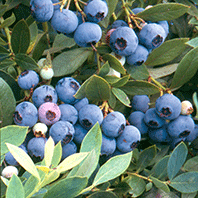 Blueberry 'Sunshine Blue'
UT
Blueberry 'Sunshine Blue'
UTVaccinium spp. hybrid Not to Norfolk Island, NT, SA, TAS or WA 'Sunshine Blue' is a low-chill variety suitable for most climate zones; it needs only 150 hours of winter chill. It grows as a semi-dwarf evergreen bush to 1 metre high and fruits heavily in summer. One of the most ornamental of the blueberries, producing hot pink flowers during late spring, so it makes an attractive fruiting hedge or looks good in containers. It is self-pollinating. More info on growing blueberries... Provided as tubestock. GB107 GB108Save $1.90 |
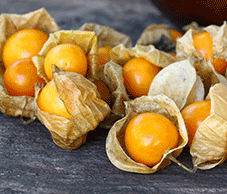 Cape Gooseberry
UT
Cape Gooseberry
UTPhysalis edulis syn. P. peruviana Not to Norfolk Island, NT, SA, TAS or WA Syn. golden berry. A short-lived perennial to 1 metre high, producing a large quantity of sweet, juicy, marble-sized golden yellow fruit encased in a lantern. Eat fresh or as jam. Cape Gooseberry is prone to pest problems in the subtropics so is best grown in more temperate areas. Provided in 100 mm pots. GC129 Available as seed... |
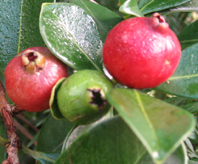 Cherry Guava syn. Strawberry Guava
UT
Cherry Guava syn. Strawberry Guava
UTPsidium littorale syn. P. cattleianum Not to Norfolk Island, NT, SA, TAS or WA Cherry Guava is an evergreen shrub with white flowers that bloom in late spring. Fruit is round, plum-sized, deep wine-red, with a very thin skin. The flesh is juicy with a sweet flavour. Cherry guavas dislike low temperatures but will tolerate some frost and are hardier to cold than the common guava. The fruit can be eaten raw and is high in Vitamin C; it is also used in jellies, drinks and jams. The plant is useful as a fruiting hedge, poultry forage and windbreak. More info on growing cherry guava... Provided as tubestock. GC111 GC140Save $1.90 Available as seed... |
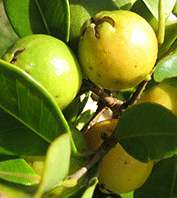 Cherry Guava 'Gold'
UT
Cherry Guava 'Gold'
UTPsidium littorale syn. P. cattleianum Not to Norfolk Island, NT, SA, TAS or WA Cherry Guava 'Gold' is a less common form of cherry guava but otherwise grows in a similar way. It is an evergreen shrub with white flowers that bloom in late spring. Fruit is round, plum-sized, golden yellow, with a very thin skin. The flesh is juicy with a sweet flavour. Cherry guavas dislike low temperatures but will tolerate some frost and are hardier to cold than the common guava. The fruit can be eaten raw and is high in Vitamin C; it is also used in jellies, drinks and jams. The plant is useful as a fruiting hedge, poultry forage and windbreak. More info on growing cherry guava... Provided as tubestock. GC170 GC171Save $1.90 Available as seed... |
 Dragon Fruit 'Aztec Gem'
UT
Dragon Fruit 'Aztec Gem'
UTSelenicereus spp syn. Hylocereus spp Not to Norfolk Island, NT, SA, TAS or WA Syn. pitahaya, pitajaya. 'Aztec Gem' has deep purple flesh with a fruity, sweet taste. Dragon fruit can be grown directly in the ground with a strong support or in large containers. Avoid planting underneath trees as the fruit will be out of reach and the vine is so heavy it can break branches. A strong trellis 1.8 to 2 m high is ideal. It fruits best once it has reached the top of support and the branches hang outwards and down. 'Aztec Gem' is a moderate grower and self-pollinating but hand pollination will increase the yield. Dragon fruit are best suited to tropical and subtropical areas. Grow it in partial shade in a very well-drained fertile soil. Provided in mini pots. GD101 GD102Save $1.90 |

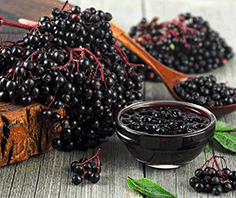 Elderberry
UT
Elderberry
UTSambucus nigra Not to Norfolk Island, NT, SA, TAS or WA Syn. black elder. Elderberry has been in use as a wild food plant for thousands of years. It is a deciduous shrubby tree that can grow more than 3 - 4 metres tall but is best kept pruned for an easier harvest. The traditional use of the ripe berries in Europe has been jams, jellies and wines but it is now attracting attention for its anti-viral properties. The clusters of small cream-coloured flowers are used as a tea or cordial. Immature berries and all other parts of the plant are toxic and should not be eaten. Cooking the berries is desirable to reduce the risk of any toxicity. The flowers are attractive to butterflies and native bees. Elderberry prefers full sun and a fertile well-drained soil. The plants can sucker vigorously so grow it somewhere that it can be easily controlled. Growing it in a big (400 L) planter bag is one way to limit its growth. To prevent it becoming a possible weed it should be netted when fruiting. It is a recommended that you check with your local government for its weed status in your area. Provided as one crown. GE105 Provided in mini pots. GE107 GE108Save $1.90 |
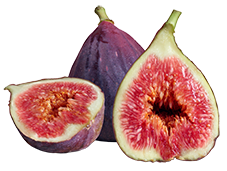 Fig 'Black Genoa'
UT
Fig 'Black Genoa'
UTFicus carica Not to Norfolk Island, NT, SA, TAS or WA Fig 'Black Genoa' is a deciduous, ornamental, self-pollinated tree, between 2 and 6 metres high. The large purplish-black fruit have a red flesh with sweet rich flavour. It grows best in full sun on a well-drained soil with a neutral pH of 6.6 - 7. It is very productive, with 2 crops a year. The fruit can be eaten fresh, dried or used to make a delicious jam. It is usually pruned to a multi-stem vase shape but can also be grown as an espalier or as a hedge. Although all figs prefer a less humid climate with dry summers, 'Black Genoa' performs well in subtropical areas. It is drought tolerant once established. Provided as tubestock. GF106 GF107Save $1.90 |
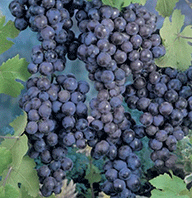 Grape 'Black Muscat'
UT
Grape 'Black Muscat'
UTVitus vinifera Not to Norfolk Island, NT, SA, TAS, VIC or WA Syn. 'Muscat Hamburg' 'Black Muscat' is a popular table grape and used for wine making in Australia. It is also suitable for drying. The large fruit are black with sweet distinctive aroma. Grapes need a well-drained soil and good air flow; too much humidity can cause mildew. Grape vines climb vigorously and need a strong trellis; it is best to plan for protection from birds when designing the trellis. Depending on area harvest is between November and February. Provided in 125 mm pots. GG195 |
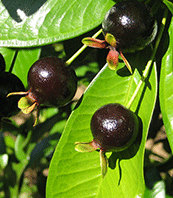
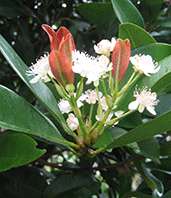 Grumichama
UT
Grumichama
UTEugenia brasiliensis Not to Norfolk Island, NT, SA, TAS or WA This is really a 'must have' small, shrubby tree if you live from a warm temperate area to the tropics. It is very attractive with glossy leaves and starry white flowers and produces fruit similar to a cherry in size and appearance. It doesn't have the dark, rich flavour of a cherry but is still very enjoyable. It will tolerate down to minus temperatures and has the added advantage of being resistant to fruit fly. It makes a good screening plant or fruiting hedge, is useful in the poultry food forest as it gives the chooks good shelter from hot sun and any circling hawks. It doesn't like drought and requires consistent watering, it will also tolerate partial shade. Unfortunately birds are keen on the fruit too, so prune it regularly to keep it bushy so a bird net can be thrown over it. Provided as tubestock. GG165 |
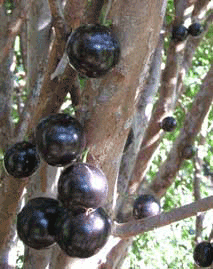 Jaboticaba
UT
Jaboticaba
UTMyrciaria cauliflora Not to Norfolk Island, NT, SA, TAS or WA An excellent ornamental shrubby tree with coppery pink new foliage suitable for a wide climate range from warm temperate to tropical areas. It tolerates light frost and is drought tolerant, although drought will impact fruiting. The fruit is similar to a large black grape and as the fruit is hidden on the internal branches there are usually few bird problems. It is also resistant to fruit fly. Jaboticabas may crop several times a year, depending on water availability and can be pruned hard to keep as a shrub. It is useful as a fruiting hedge and the fruit may be eaten fresh, made into a delicious jam, wine or liqueur. Provided as tubestock. GJ116 GJ117Save $1.90 |
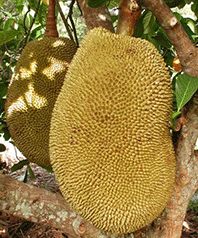 Jackfruit
UT
Jackfruit
UTArtocarpus heterophyllus Not to Norfolk Island, NT, SA, TAS or WA Syn. jakfruit, arbol del pan, jaquiero, kathal. Jackfruit are highly productive, attractive, evergreen large trees to 10 metres plus suited to tropical and subtropical areas. Trees can be kept to a home garden size with appropriate pruning. The fruit is eaten as a vegetable when picked young, at around 1 kg in size. When fully ripe the delicious fruit can be used in ice cream, desserts, smoothies or dried. The protein-rich seeds can be boiled, peeled and roasted. Jackfruit is self-pollinated by wind and insects but fruit set and fruit quality are improved by cross pollination. Grow it in full sun in a fertile well-drained soil pH 6.6 to 7.3. Space the trees 6 to 12 m apart. Grown from seed. Provided in mini pots. GJ101 GJ102Save $1.90 |
 Japanese Raisin Tree
UT
Japanese Raisin Tree
UTHovenia dulcis Not to Norfolk Island, NT, SA, TAS or WA Japanese Raisin Tree syn. Chinese Raisin Tree is an ornamental shade tree well-suited to the home garden and school playgrounds. It grows well with little care and attention. A deciduous tree, it grows to a height of 6 - 9 m with a spread of 4 m. It is suited to temperate and subtropical climates and is very hardy to cold. It produces copious quantities of sweet, raisin-like, edible fruit. It is tolerant of wide range of soil types but prefers good drainage. Space trees 4 m apart in full sun. More info on growing Japanese Raisin Tree... Provided as tubestock. GJ107 GJ110Save $1.90 Available as seed... |
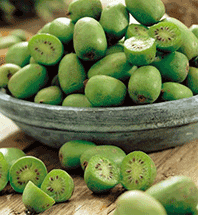 Kiwiberry 'Issai'
UT
Kiwiberry 'Issai'
UTActinidia arguta 'Issai' Not to Norfolk Island, NT, SA, TAS or WA Syn. hardy kiwifruit. Kiwiberry 'Issai' is a very hardy, fast-growing, self-fertile fruiting vine. The green fruit is smooth, hairless and grape-sized; it is a close relative of kiwifruit with the same delicious flavour but usually sweeter. It is a good choice for urban backyards as it takes up far less space and doesn't require a second vine for pollination. That being said, most self-fertile fruits still crop better with a companion nearby. It is a very hardy plant that is frost tolerant and disease resistant. It prefers a position in full sun but will tolerate partial shade with protection from strong winds. The soil should be well-drained, fertile with a pH of 5.5 - 7.0. It requires a strong trellis or fence to grow on. Provided in mini pots. GK120 GK121Save $1.90 |
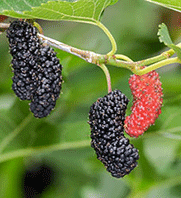 Mulberry 'Majestic Dwarf'
UT
Mulberry 'Majestic Dwarf'
UTMorus nigra Not to Norfolk Island, NT, SA, TAS or WA This is a true dwarf mulberry that grows to only a quarter the size of normal mulberry, it is easily maintained to around 3 m high. The delicious fruit is medium to large, black and sweet but with a balanced acidity. Its compact size makes it versatile as a fruiting hedge, large container plant, or as a feature plant in a garden or courtyard. It prefers full sun and makes a good shade tree on the western side of the house and is ideal to provide shelter in the chook run. 'Majestic Dwarf' is a low chill cultivar so crops well in QLD. Mulberries are deciduous and tolerant of a wide climate range so will produce from the Northern Territory to as far south as Tasmania. Trees are self-pollinated so only one is needed for a good crop. Provided in mini pots. GM134 GM135Save $1.90 |
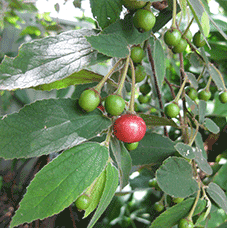 Panama Berry
UT
Panama Berry
UTMuntingia calabura Not to Norfolk Island, NT, SA, TAS or WA Syn. strawberry tree, calabur, Jamaica cherry. Panama Berry is an attractive, small tree, 5 - 10 metre high, with weeping branches and small white flowers. It is fast growing and fruits in the first year. Flowers and fruit appear over a long period so provide a sweet snack for the gardener. The small, sweet, red berries have been described as caramel flavoured and can be eaten fresh or used for jams. It can also be grown as a large container plant and responds well to pruning. It is drought hardy and pest resistant. It is an excellent choice as a shade tree for kid's play areas. Provided as tubestock. GP207 GP208Save $1.90 |

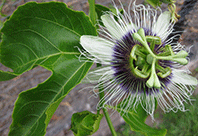 Passionfruit 'Panama Gold'
UT
Passionfruit 'Panama Gold'
UTPassiflora flavicarpa x Passiflora edulis Not to Norfolk Island, NT, SA, TAS or WA 'Panama Gold' produces very large, deep golden fruit with a delicious sweet, tangy flavour. It is a vigorous climbing plant with lush, deep green attractive leaves and showy purple and white flowers. It is self-pollinating and produces prolifically. Grow on a strong trellis for support. Does well in subtropical and tropical areas. In temperate areas requires a warm, sheltered position and may lose its leaves during winter. Provided as tubestock. GP157 GP158Save $1.90 |
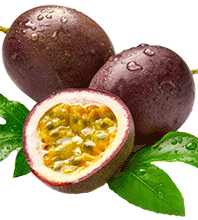 Passionfruit 'Panama Red'
UT
Passionfruit 'Panama Red'
UTPassiflora flavicarpa x Passiflora edulis Not to Norfolk Island, NT, SA, TAS or WA 'Panama Red' produces very large, red skinned fruit with a delicious sweet, tangy flavour. It is a vigorous climbing plant with lush, deep-green attractive leaves and showy purple and white flowers. It is self-pollinating and produces prolifically. Grow on a strong trellis for support. Does well in subtropical and tropical areas. In temperate areas requires a warm, sheltered position and may lose its leaves during winter. Provided as tubestock. GP198 GP199Save $1.90 |
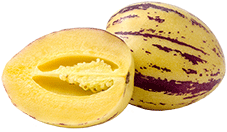 Pepino 'Kendall Gold'
UT
Pepino 'Kendall Gold'
UTSolanum muricatum Not to Norfolk Island, NT, SA, TAS or WA Syn. pepino dulce. The pepino is a native of the Andes in South America. It is in the tomato family and grows as a small sprawling bush 80 - 100 cm tall. 'Kendall Gold' is an improved selection that produces yellow fruit striped with purple that has a sweet, delicate, mild flavour, similar to a melon. It does best in warm climates but will tolerate light frost. It is suited to fertile, moist soils in full sun although it will grow in partial shade it will be less fruitful. It is easy to strike from cuttings; new bushes should be planted every few years as it bears less with age. The sprawling habit makes it useful as a groundcover but growing it on a trellis protects the fruit from attack by slugs and snails and from rotting from contact with the soil. Suitable for warm temperate and subtropical areas. Provided as tubestock. GP182 GP183Save $1.90 |
|
Raspberry
Rubus idaeus If you live in an area that will grow raspberries then why wouldn't you? Raspberries are a luscious fruit for eating fresh or preparing as a wonderful dessert. Raspberries are a berry fruit that grow as a herbaceous perennial. The fruit are produced on prickly stems (canes) on a shallow-rooted bush. Raspberries are grouped into two types, floricanes and primocanes. Summer Fruiting varieties bear fruit on floricanes and include cultivars such as 'Willamette', 'Everbearer', 'Nootka', 'Chilcotin' and 'Tulameen'. These types of raspberries are better suited to cooler areas with low humidity. Fruit is produced from late November to early January on canes that grew the year before. Autumn Fruiting varieties such as 'Heritage' and 'Autumn Bliss' produce fruit on current season's canes in autumn and are tolerant of a warmer climate. Raspberries require a sunny position, sheltered from hot winds, but with good air drainage to reduce fungal problems. A deep, well-drained soil that is slightly acid, rich in organic is preferred. Keep the plants well mulched to prevent roots drying out and competing weed growth. Spray regularly with seaweed fertiliser to strengthen the plant and reduce fungal problems. A trellis should be erected at the time of planting to keep the canes and fruit off the ground. When tying plants to the trellis an open well-spaced arrangement will reduce fungal problems. Keep in mind bird and possum protection as absolutely everything loves raspberries! |
 Raspberry 'Tulameen'
Raspberry 'Tulameen'
 UT
UTRubus idaeus Not to Norfolk Island NT, SA, TAS or WA Raspberry 'Tulameen' has luscious, large, conical fruit with an excellent flavour and it is a heavy cropper over an exceptionally long period. It is a Summer fruiting variety and requires around 450 chilling hours or greater. It produces on second-year wood (floricanes). The canes grow to 1.5 m tall and can be tied to a trellis or tripod and are relatively spine-free. 'Tulameen' has good disease resistance. Provided as tubestock. GR144 GR145Save $1.90 |
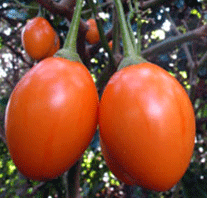 Tamarillo 'Ecuadorian Orange'
UT
Tamarillo 'Ecuadorian Orange'
UTCyphomandra betacea Not to Norfolk Island, NT, SA, TAS or WA Syn. tree tomato, tomate de arbol. Produces abundant quantities of sweet, tangy fruit over a long season. The flesh of the orange tamarillo is sweeter than red types and a good source of Vitamin C. It is a small tree 3 - 5 m high that can live up to 12 years. It is a good fill-in plant as it only takes 18 months to produce the egg-shaped fruit. In the kitchen it can be used to make jam or chutney, added to salads, poached in syrup as a dessert or to make salsa. It is frost tender and needs a very well-drained soil. It is suitable for subtropical and tropical areas. More info on growing Tamarillo... Provided as tubestock. GT120 GT121Save $1.90 Available as seed... |
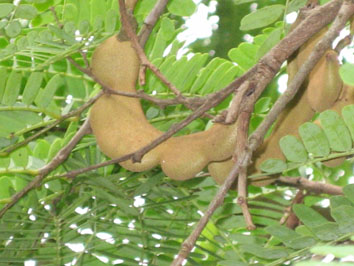 Tamarind
UT
Tamarind
UTTamarindus indica Not to Norfolk Island, NT, SA, TAS or WA Tamarind is an evergreen tree, 18 - 25 m in height, native to tropical Africa. It is a traditional shade tree of villages in Africa and India. It is grown for its edible pods, which are dark brown and sweet when ripe. The leaves and flowers are also eaten. The timber is strong and termite-proof, used for furniture and tool handles. Tamarind likes a dry, sandy soil and is tolerant of drought and coastal conditions. It needs a seasonal dry season to encourage flowering. Young trees are frost tender, however they develop more cold tolerance as they mature. Suitable for subtropical and tropical areas. Provided in mini pots. GT115 GT145Save $1.90 |
|
Green Harvest specialises in plants which are:
|
Not to NORFOLK ISLAND, NT, SA, TAS or WA
SORRY but due to quarantine restrictions between Australian States no plants at all can be ordered by residents of Norfolk Island, Tasmania and Western Australia. These restrictions are very important as they prevent the spread of plant pests and diseases. No potatoes, garlic, shallots, strawberries or tubestock can be sent to South Australia. No tubestock can be sent to Northern Territory.
SORRY but due to quarantine restrictions between Australian States no plants at all can be ordered by residents of Norfolk Island, Tasmania and Western Australia. These restrictions are very important as they prevent the spread of plant pests and diseases. No potatoes, garlic, shallots, strawberries or tubestock can be sent to South Australia. No tubestock can be sent to Northern Territory.
 Home
Home
Green Harvest Organic Gardening Supplies is permanently closed as of 5pm on 1-11-2023.
We will not be taking orders by this website, in person, by phone or email. Our display garden and retail shop are closed forever.
Read more...
Phone:07 54357000
Phone calls will only be responded to sporadically and only in reference to orders placed prior to 2-11-2023. All the useful growing and organic pest management research and resources are available on this website for a while still.
No liability will be accepted by Green Harvest, its owners or employees as to the accuracy of any information. No responsibility will be taken for damage to property or persons due to information given about a product or technique. No responsibility will be taken for the loss of a crop or income due to information given about a product or technique.
 Shopping here is private and secure.
Shopping here is private and secure.
Copyright © 2001 - 2024 Green Harvest Organic Gardening Supplies
No part of this website may be reproduced without permission of the owner


